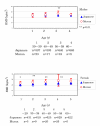Investigation of oxidative stress and dietary habits in Mongolian people, compared to Japanese people
- PMID: 16759377
- PMCID: PMC1523336
- DOI: 10.1186/1743-7075-3-21
Investigation of oxidative stress and dietary habits in Mongolian people, compared to Japanese people
Abstract
Background: The average life span of Mongolians is 62 years for males and 69 years for females. This life span is about 16 years shorter than that of Japanese. Mongolian people generally eat meat, fat and diary products but less vegetables or fruit. Thus, we investigated the state of oxidative stress and dietary habits of Mongolians.
Methods: The investigation was performed in Murun city in the northwest area of Mongolia. A total of 164 healthy subjects (24-66 y) were enrolled. As a marker of reactive oxygen species, the levels of reactive oxygen metabolites (ROM) were measured using the d-ROM test. Interviews about dietary habits were performed using the Food Frequency Questionnaire established by the Kagawa Nutrition University.
Results: ROM levels were 429.7 +/- 95.2 Carr U for Murun subjects, whereas Japanese people (n = 220, 21-98 y) showed 335.3 +/- 59.8 (p < 0.001). The levels of serum malondialdehyde-modified low-density lipoprotein-cholesterol and urinary 8-hydroxydeoxyguanosine were also high. ROM levels correlated with body fat ratio and inversely correlated with handgrip strength. Handgrip strength in the subjects over 45 years decreased more rapidly than that of age-matched Japanese. Murun subjects ate larger amounts of meat, fat, milk and flour and dairy products than Japanese, but less vegetables or fruit. Serum vitamin A and E levels were the same as Japanese references, but vitamin C levels were lower.
Conclusion: Murun subjects may be in high oxidative stress, which may have a relationship with early ageing and several diseases, ultimately resulting in their short life span. In order to increase antioxidant capacity and suppress overproduction of ROM, antioxidant food intake is recommended.
Figures








References
-
- Statistics Bureau International Statistical Compendium 2004. Ministry of Public Management, Home Affairs, Posts and Telecommunications Japan. 2005.
-
- Komatsu F, Hasegawa K, Watanabe S, Kawabata T, Yanagisawa Y, Kaneko Y, Miyagi S, Sakuma M, Kagawa Y, Ulziiburen C, Narantuya L. Comparison of electro-cardiogram findings and lifestyles between urbanized people and ger-living people in Ulaanbaatar, Mongolia. Atherosclerosis. 2004;175:101–108. doi: 10.1016/j.atherosclerosis.2004.03.005. - DOI - PubMed
-
- Holick CN, Michaud DS, Stolzenberg-Solomon R, Mayne ST, Pietinen P, Taylor PR, Virtamo J, Albanes D. Dietary carotenoids, serum β-caroten, and retinol and risk of lung cancer in the Alpha-Tocopherol, Beta-Carotene Cohort Study. Am J Epidemiol. 2002;156:536–547. doi: 10.1093/aje/kwf072. - DOI - PubMed
-
- Cornelli U, Cornelli M, Terranova R. Free-radical and vascular disease. The International Union of Angiology's Bulletin. 1999;15:7–10.
LinkOut - more resources
Full Text Sources
Research Materials

